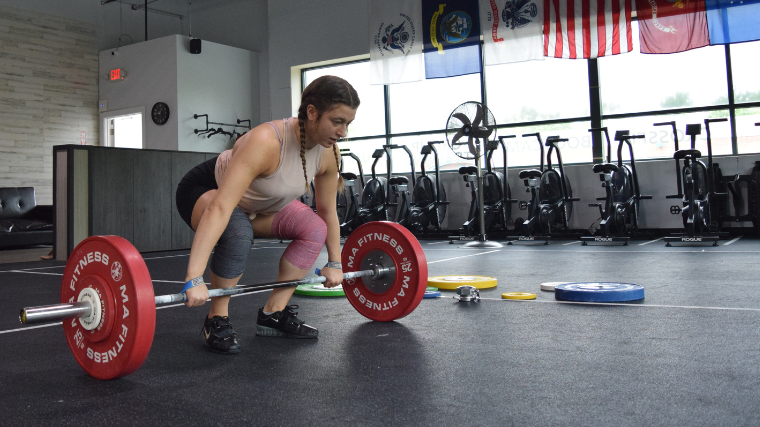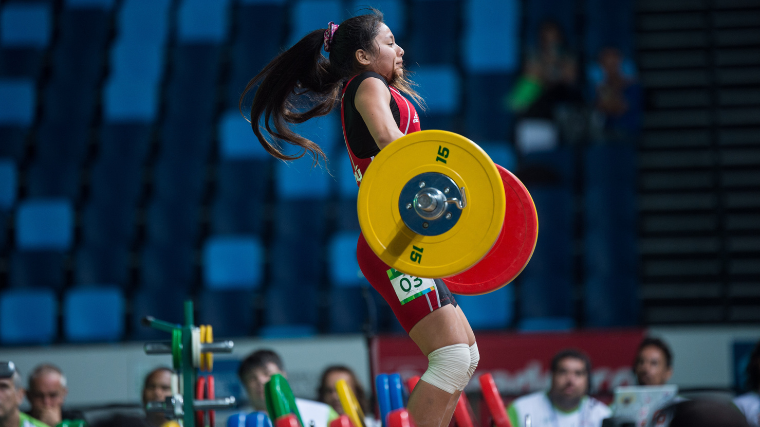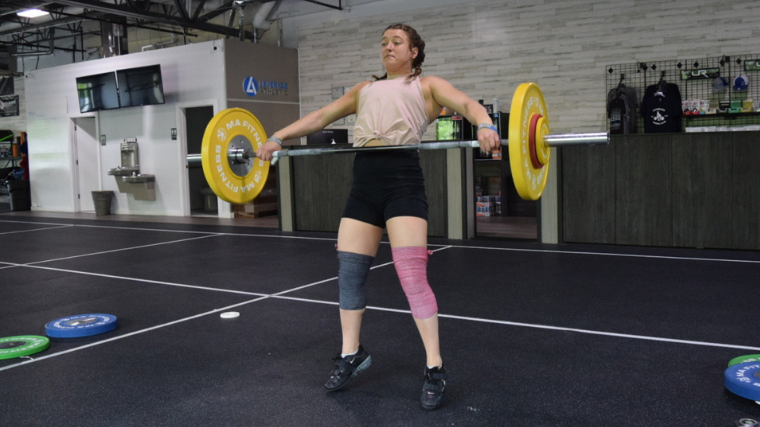In weightlifting, the snatch and the clean & jerk are the two disciplines tested in competition. They’re complicated and take a long time to master. The more you practice them, the better, but frequency isn’t everything. To do well at the Olympic lifts, you have to practice your squats, pulls, and different accessories every week.
It would be nice to do everything every week, but there’s only so much time available for training. On top of training, you must make time to recover, fuel your body, and sleep for optimal performance.

Successful training in weightlifting looks different for everyone. The frequency that you should practice the main lifts depends on so much, and it even changes over time.
This is everything you need to determine your ideal amount of training for the Olympic lifts.
- What Is Frequency?
- Benefits of Increasing Your Frequency
- Factors to Consider
- How to Determine the Right Frequency
- Sample Training Programs (Low vs. High-Frequency)
What Is Frequency?
Training frequency refers to how often you exercise in the gym. More specifically for the sport of weightlifting, it’s how often you do certain exercises during your training plan — usually measured on a per-week basis. You should plan your frequency to align with the things that you need to work on the most.
Meeting your goals takes a lot of consistent effort. Almost always, there’s so much work to do, and only a certain amount of time to do it all. Monitoring the frequency of your exercises (such as the snatch and clean & jerk) is how to productively stay on task for progress.
Benefits of Increasing Your Frequency
In weightlifting, the more time you have to work on your weaknesses and strengthen your strengths, the better. Training is most effective when you can get in the gym multiple days per week. Here’s why you should keep your frequency high.
More Technical Practice
The snatch and clean & jerk require heaps of technique work and learning, and they take years to master. Therefore, the more practice you can fit into one training week, the faster you’ll excel.
If you take your training frequency up a notch (or two), you’ll notice that your form and posture improve much faster than if you only practiced the lifts every Monday.
You Can Work On Weaknesses
There are a lot of different parts to the Olympic lifts. When you do them for a while, you pick up on what you’re good at, and should begin to notice what areas need improvement.
Adding extra bouts of practice allows you to focus more on what you struggle with, which will get you closer to reaching your goals.
Increased Productivity
Hard work pays off. Spending high-quality time on the lifts is how you become proficient at them. An extra day of training, or even a few extra sets of the lifts per session, will allow you to get stronger and achieve more from your routine.
When you add extra sets to your training, it doesn’t all have to be more heavy work. Extra practice can be in the form of a longer warm-up, more empty barbell work, and more quality technical training.
For the best return on your investment, you should kick up your frequency through a variety of different exercises and modalities.
Factors to Consider
There is a lot to think about when making a plan, whether you’re a dedicated weightlifter or just going to the gym to get in shape. These are some of the major factors that determine how much training you should do, and how often.
Experience Level
Your “training age” is how long you’ve spent routinely practicing weightlifting. The longer you’ve been in the game, the more tolerant you are to high-volume, high-frequency workouts.
At first, you should practice the Olympic lifts only two or three days per week in combination with lots of other strength work and accessories.
You can gradually include more of the main lifts in your plan as time goes on, until you’re working on your weightlifting as often as five to six days per week.
Age
Along with your training age, there’s also your biological age. Athletes of differing ages have different work and recovery capacities, especially when you’re a beginner. Your age plays a large part in how intense your training can (or can’t) be.
Youth weightlifting is safe at the proper intensity, which greatly varies per student. Young lifters ages 13 & under should practice the movements with no weight on their bars, or work with a light dowel when they’re getting started. Make the goal to practice more repetitions rather than adding weight.
If you’re picking up Olympic lifting later in life, power to you! Be cognizant of your recovery habits and don’t try to keep up with the younger athletes in your gym. Start with an empty bar and infrequent practice (twice per week is plenty) until your body adjusts to the rigors of training.
Free Time
Unlimited time for training would be amazing, but inevitably, life tends to get in the way. Most people have to work during the day, which means that you can’t just train whenever you want.
Your free time should be your time to rest, but if you have some spare hours in your week, use it for practice. Some people have very little free time, but success is still possible. If that’s the case for you, consistency is key.
Even if you only have one or two hours per week to work on your weightlifting, you can still find progress as long as you show up for each and every session. Those workouts may just have to be a bit shorter than you’d like.
Goals
Being successful in weightlifting means reaching the goals that you set for yourself. Since everyone’s goals are different, everyone’s training will look a bit different, too. Your desired outcome influences how much training needs to be done during the week.
If your goal is to keep getting stronger, you have to make your training sustainable, which means an equal balance of training and rest. Do the Olympic lifts as often as three to five days per week to keep your intensity high with adequate rest.

Elite training is a different story. If your goal is to be the best weightlifter around or to compete at a national (or even international) level, then you have to take your frequency up to the max — professional athletes train as often as six to eight times per week, and sometimes more.
Note that ultra-high training frequencies are usually prescribed and overseen by a qualified weightlifting coach, and aren’t appropriate for recreational lifters.
Recovery
At the end of the day, your body decides what amount of training is tolerable. Everyone is built differently, meaning that some people need more rest and recovery than others.
Prioritizing your recovery is what creates an optimal training environment long-term. When you first start practicing the Olympic lifts, you should train only up to four days per week, while placing extra emphasis on recovery work. Gradually introduce more intense training days as it feels right.
How To Determine the Right Frequency
You should be in charge of how many days per week you train the lifts. These strategies help you decide what amount of training is right for your needs in the gym.
Step 1 — Set Goals
First, you have to think about what you want to accomplish in weightlifting. For many, the snatch and clean & jerk serve as enjoyable exercises that make you stronger.
For others, it’s about measurable progress to becoming the best athlete or starting a career in strength. The more rigorous your goals are, the more training you’ll have to do to reach them.
Step 2 — Consider Your Schedule
Your frequency is only as effective as you’re able to adhere to. Having five weekly sessions on paper doesn’t mean much if you only show up for three of them.
As such, consider your overall schedule and determine how much time you actually have. Note the times that you’re free to work out. If there are lots of openings, plug in as many as five days of the week that you’ll stick to for your training times.
If you’re limited on time, focus on getting in the gym regularly and not missing a session. If your schedule fluctuates, plan your frequency for training in advance so you can stay on track. It’s better to get two quality sessions in every week than four or five haphazard workouts sporadically.
Step 3 — Find the Right Program
The best way to organize your frequency is to follow a program. Working with a coach is the best way to ensure your program suits you because they can personalize your plan and adjust it as you go.
If coaching isn’t an option, there are plenty of online resources for you to explore. Do your research on which programs cater to different weightlifting goals to find the right program for you, but be warned that this process will likely include some trial and error.
Step 4 — Be Flexible
Dedication to your weightlifting training is important. That said, life does get in the way from time to time. Even if you’ve decided to train your Olympic lifts three times per week, there’s a chance that you’ll miss a workout or have to alter your training for some reason.
In those cases, don’t be afraid to get flexible with your programming. If you’re only going to work out twice per week (instead of three times), you can bump up your training volume on those workouts to account for the lower frequency.
Once the week is over and you’re back on your regular schedule, proceed as usual.
Sample Training Programs (Low vs. High-Frequency)
The shape of your weightlifting training will look quite different depending on how often you can get into the gym. Having between four and six days to work on your technique and strength is a luxury, but you can make some decent progress with lower-frequency training as well.
Low-Frequency
Generally speaking, low frequency for weightlifting would be fewer than three days in the gym. If you can only practice twice per week, your workouts will take a bit longer and cover more bases athletically.
Your first of two weekly workouts might organize your exercises like so:
- Snatch
- Power Clean (or Jerk)
- Back Squat
- Snatch Pull
- Accessories
Later in the week, you’d fill in some of the gaps with other primary movements:
- Power Snatch
- Clean & Jerk
- Front Squat
- Clean Pull (or Deadlift)
- Accessories
This way, you’re still practicing both competition lifts in one form or another twice per week. You’re also pulling and squatting twice, and getting some accessory work in as well. The downside here is that your workouts might run a bit long, depending on your individual volume.
High-Frequency
Having four or more days per week to train weightlifting is an embarrassment of riches. With so much real estate available, you can guarantee that you’re giving adequate time to practicing the competition movements while also developing secondary muscles and building strength.

For example, you could spread out your training across five days. The first day could be:
- Snatch
- Snatch Pull
- Front Squat
On day two, you’d give some time to accessory work and secondary movements:
- Muscle Clean
- Push Press
- Pull-Up
- Back Extension
Day three would see you return to more specific training:
- Power Clean
- Power Snatch
- Block Jerk
- Back Squat
You could use the fourth day for a bit of “beach work” and some active recovery:
- Snatch Press
- Upright Row
- Weighted Plank
- Walking Lunge
And on the final day, dedicate your attention fully to performing the two main movements together so you’re prepared for an upcoming competition:
- Snatch
- Clean & Jerk
- Clean Pull
- Front Squat
High-frequency plans give you the opportunity to tackle fewer movements with more focus per session. However, you’ll have to adjust to training similar muscle groups and movement patterns on subsequent days, so be sure to prioritize recovery and monitor muscle soreness.
More Is More, Usually
Weightlifting is easy to begin but extremely difficult to master. From the first day you pick up a barbell, the movements will challenge your focus and dedication. But with the right amount of practice, you can achieve your potential and even be competitive on the platform if you so choose. No matter your “why,” you need to hammer down your “when.”
And when it comes to deciding on how much to train, don’t overcomplicate things. There isn’t one answer that works for everyone, so there won’t be a true “perfect” amount of frequency either.
If you like improving your weightlifting and have the time for a high-frequency program, go crazy. But don’t give up on your goals because you can’t train every day of the week.
Featured Image: Riley Stefan